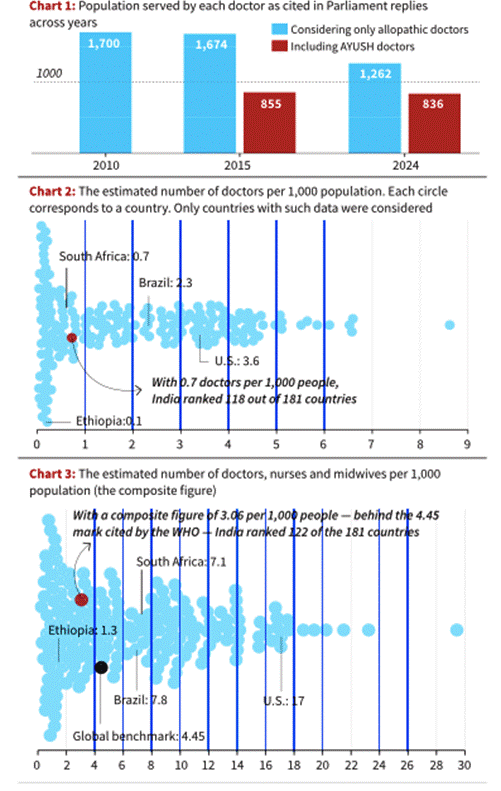Why it is in news ?
- Government replies in Parliament (2015 and 2024) cited a WHO benchmark of 1 doctor per 1,000 population.
- The Hindu’s investigation shows WHO has never prescribed this norm.
- WHO issued a written clarification to The Hindu confirming: it does not recommend doctor-population ratios for countries.
- Government calculations were found inconsistent:
- Only 80% availability factor applied to allopathic doctors.
- No availability factor applied to AYUSH practitioners.
- Inclusion of AYUSH doctors helped the government claim it meets the supposed ratio.
- Raises questions on data transparency, policy accuracy, and misinterpretation of global health norms.
Relevance
GS2 – Health / Governance
- HRH planning under National Health Policy.
- Data integrity and parliamentary accountability.
- Rural–urban health workforce maldistribution.
- Overreliance on “composite workforce” metric.
GS3 – Economy
- Impact on health expenditure planning.
- Workforce shortages affecting productivity, demographic dividend.

What is the claimed “WHO ratio”?
- Popularly cited norm: 1 doctor per 1,000 population.
- Policymakers, medical bodies, and public discourse often present it as WHO-prescribed.
- Reality:
- No WHO document prescribes this ratio.
- No global standard exists for doctor-only ratios.
- The figure spread through academic citations, policy reports, and government statements without primary source evidence.
What does WHO actually prescribe?
- WHO clarified that it does not issue country-level doctor ratios because health workforce needs depend on:
- National disease burdens,
- Health labour markets,
- Infrastructure,
- Demography and epidemiology.
- WHO uses composite workforce benchmarks, not doctor-only ratios.
WHO benchmarks:
- 2006 global threshold:
- 2.25 doctors, nurses, midwives per 1,000 population
- Minimum required for essential maternal and child health services.
- Revised SDG Composite Index (current):
- 4.45 doctors + nurses + midwives per 1,000 population
- Needed to achieve 80% coverage on 12 SDG-linked health indicators.
How did the 1:1,000 myth originate?
- Public health expert Dr. Kumbhar traced the earliest official Indian reference to:
- Medical Council of India (MCI) “Vision 2015” report (2011).
- That report—based on expert consultations—recommended 1:1,000 as a target, not a WHO norm*.
- Later, the figure was cited in:
- Parliamentary answers
- Academic articles
- Policy discussions
- Media narratives
- Over time, it became politicised, especially in debates over:
- Need for more medical colleges
- Inclusion of AYUSH doctors in workforce counts
- Shortages exaggerated to justify rapid medical infrastructure expansion
Government’s use of the ratio (2015–2024)
- Government replies cited the 1:1,000 ratio while measuring India’s doctor availability.
- Issues in calculation:
- Allopathic doctors: only 80% counted, as per availability
- AYUSH doctors: 100% counted, no availability adjustment
- Inclusion of AYUSH boosted India’s numbers closer to the “benchmark”
Result:
- Produced inconsistent doctor-population ratios (shown in multiple Lok Sabha and Rajya Sabha responses).
- Demonstrates selective application of workforce metrics.
What do global datasets show?
Based on WHO’s National Health Workforce Accounts (NHWA):
a) Doctors per 1,000 population (Chart 2)
- India: 0.7 per 1,000
- Rank: 118 out of 181 countries
b) Composite health workers (doctors + nurses + midwives) per 1,000 (Chart 3)
- India: 3.06 per 1,000
- Rank: 122 out of 181 countries
- Below WHO’s SDG threshold: 4.45
Real issue: maldistribution, not raw numbers
- Urban–rural divide is the core problem:
- Large concentration of doctors in metros and Tier-1 cities.
- Severe shortages in rural PHCs, CHCs, tribal areas.
- State variation is high:
- Some states exceed global benchmarks; others are far below.
- Raw national ratios hide structural gaps in:
- Quality of care
- Skilled nursing supply
- Midwifery cadres
- Rural incentives
- Regulatory standards
Policy implications
- Misstating WHO norms risks:
- Misaligned workforce planning
- Policy errors in medical education expansion
- Overreliance on numeric targets
- Shift needed toward:
- Local workforce forecasting
- State-specific staffing models
- Strengthening nurses and midwives
- Incentivising rural practice
- Accurate measurement and availability-adjusted counts
Conclusion
- India’s debate on doctor shortages is driven by a mythical benchmark, not evidence.
- WHO’s actual focus is on composite health workforce sufficiency, not doctor-specific norms.



